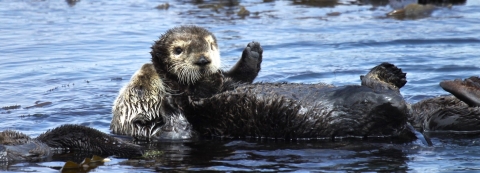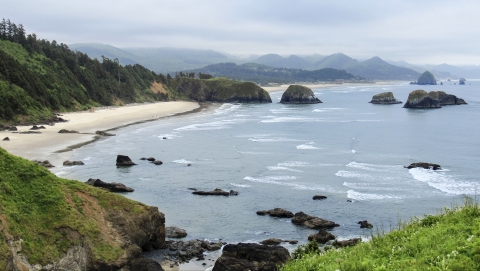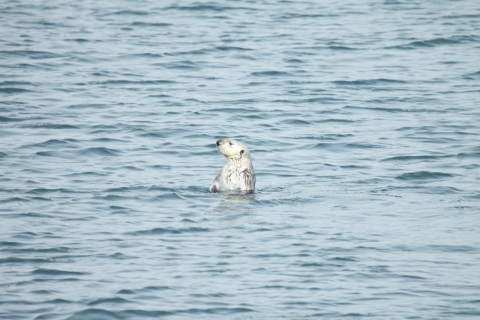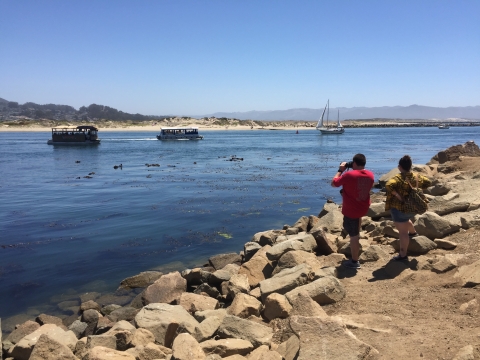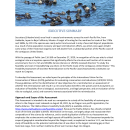States
California, OregonTo be added to our mailing list, please use the button below to sign up for updates via email and put the word “subscribe” in the subject line. We will keep you informed of any events and opportunities for public engagement.
Open House Report now available
Last summer the U.S. Fish and Wildlife Service held a series of community open houses to gather perspectives and share information on potential sea otter recovery efforts in Oregon and Northern California. This followed the release of a Feasibility Assessment of Sea Otter Reintroduction to the Pacific Coast, developed at the direction of Congress in 2022. We held these sessions in 16 coastal communities along our coast, from Astoria, Oregon, to the San Francisco Bay Area in California.
These informal events were a chance for us to meet one-on-one with members of the public to learn more about their interests, perspectives, and concerns about the idea of restoring sea otters to the ecosystem. We are pleased to share a summary of the key messages we heard from community members who attended these open houses. Our interactions with community members were informative and enlightening, and we hope you will also find value in learning more about the breadth of perspectives represented by open house participants through this report:
There is no proposal to reintroduce sea otters at this time, and this is not a formal comment period. We are interested in learning what factors you think are important for the U.S. Fish and Wildlife Service to evaluate as we determine the next steps, if any, in the consideration process. The Service aims to be inclusive, thoughtful, and scientifically sound as we consider actions to support sea otters and ecosystem recovery, now and in the future.
We want to hear from you! As we consider potential reintroduction, what socioeconomic criteria (types of effects) should we be thinking about if selecting possible reintroduction sites for further study? Send your suggestions to pacificcoastseaotters@fws.gov. Please note this address is not monitored on a regular basis; if you need a reply, please see our contacts under “For more information” at the bottom of this page.
What's next?
The Service will continue to engage stakeholders and Tribes as we evaluate potential sea otter reintroduction scenarios with the help of expanded scientific modeling from the scientific community. This next step is identified in the Service's feasibility assessment (Next Step 6.4.6) as a key component to further exploration of sea otter reintroduction.
Read the U.S. Fish and Wildlife Service’s report “Feasibility Assessment: Sea Otter Reintroduction to the Pacific Coast”
The U.S. Fish and Wildlife Service was directed by Congress to look at the feasibility and cost of reintroducing sea otters on the Pacific Coast, including Oregon, Washington, and California. This directive stemmed from language that was included in the Consolidated Appropriations Act for 2021, Sea otters have been absent from most of the Pacific Coast for more than 100 years, since their near extinction as a result of the maritime fur trade.
- Read the Executive Summary of the report.
- Download the report in its entirety.
While the Service’s assessment indicates that reintroduction of sea otters to portions of the West Coast of the contiguous United States is feasible, stakeholder input and additional information are needed to help inform any future reintroduction proposal. The Service has not made any recommendation as to whether reintroduction should take place, but the assessment outlines a series of next steps for further exploring the possibility of sea otter reintroduction.
Does this mean reintroduction is moving forward?
The Service will continue to gather input and information to inform next steps. No decision to move forward has been made, and there is no active proposal to reintroduce sea otters at this time. Assessment of feasibility is the first step in any potential reintroduction effort, but it is not a reintroduction proposal. In the future, should there be a move to formally propose the reintroduction of sea otters, the U.S. Fish and Wildlife Service would need to initiate a National Environmental Policy Act review process that includes public engagement, including input from a broad range of stakeholders during scoping, and an opportunity for public review and comment prior to any formal decision.
Don’t we already have sea otters?
Once ranging across the North Pacific Rim from Japan to Baja California, sea otters were hunted nearly to extinction for the fur trade in the 1700s and 1800s. By 1906, Oregon’s sea otters had been entirely extirpated and — aside from a few wandering individuals that occasionally show up from Washington’s Olympic coast — the only sea otters you see in Oregon now are at the Oregon Zoo or the Oregon Coast Aquarium. In California, a population of about 3,000 southern sea otters, a threatened subspecies, is found off the central coast. A small translocated population also exists at San Nicolas Island, in southern California. All southern sea otters are descendants of a single tiny population that survived the fur trade. More information.
Why consider the reintroduction of sea otters?
The Congressional mandate to the U.S. Fish and Wildlife Service points to the sea otter’s “critical ecological role in the marine environment as a keystone species that significantly affects the structure structure
Something temporarily or permanently constructed, built, or placed; and constructed of natural or manufactured parts including, but not limited to, a building, shed, cabin, porch, bridge, walkway, stair steps, sign, landing, platform, dock, rack, fence, telecommunication device, antennae, fish cleaning table, satellite dish/mount, or well head.
Learn more about structure and function of the surrounding ecosystem.” Sea otters are also help in our fight against climate change. More information.
Why does the feasibility assessment focus on potential reintroduction efforts in Northern California and Oregon?
Today, there are two distinct sea otter subspecies in the U.S., the northern sea otter and the southern (or California) sea otter. Northern sea otters live in the nearshore waters of Alaska, British Columbia, and Washington State, and southern sea otters live along the central coast of California and at San Nicolas Island in southern California. Historically sea otters were distributed continuously along the north Pacific Rim, with Oregon serving as a transition zone between the two subspecies. Reintroducing sea otters to northern California and Oregon would help increase genetic diversity and long-term sustainability of sea otters in the wild by beginning to reconnect the northern sea otter and southern sea otter subspecies. Scientists have identified that northern California and Oregon have suitable habitat to support sea otters, and this area constitutes the largest remaining gap in the formerly continuous historical range of the sea otter.
Why was Washington not considered in the feasibility assessment?
We concluded that reintroductions in Washington would yield little conservation return for the investment of resources. Washington has already reestablished a growing population of sea otters that will likely continue to expand southward in Washington State. Also, since sea otters from the Washington population are occasionally found in Oregon, there would be opportunity for a potential Oregon population to genetically mix with sea otters from Washington.
Why was southern California not considered in the feasibility assessment?
Southern California has abundant, high-quality habitat for sea otters, and reestablishing sea otters in southern California would help to repopulate the portion of the southern sea otter's historical range in Baja California, Mexico. Additionally, reestablishing sea otters in southern California would enhance ecosystem resilience through the return of a native keystone species. However, for the purposes of the current Assessment, we prioritized the portion of the sea otter’s historical range in northern California and Oregon for evaluation because (1) southern California has at least the potential to be repopulated by sea otters dispersing from the nearshore area of Point Conception or San Nicolas Island, (2) the gain in ecosystem resilience from sea otter reintroduction in southern California would be less than that in northern California or Oregon because southern California ecosystems have a greater redundancy in sea urchin predators, and (3) a southern California reintroduction would not increase connectivity and gene flow between the northern and southern sea otter subspecies.
What is the status of the southern sea otter and how does it relate to consideration of reintroduction?
Since 1977, southern sea otters have been listed as a threatened species under the Endangered Species Act. The Service reaffirmed threatened status for the southern sea otter in September 2023 with the announcement of a not-warranted 12-month finding on a petition to remove ESA protection for the southern sea otter. This finding was based on an in-depth review of the species in a species status assessment (SSA) report—a thorough review of the taxonomy, life history, ecology, current status, and projected future status of the southern sea otter.
In the course of the 12-month finding, the Service also reviewed the criteria for endangered, threatened, and delisted status in the 2003 recovery plan for the southern sea otter and concluded, based on the best available scientific information, that they are not appropriate metrics against which to gauge the recovery of the southern sea otter. As a consequence, the Service is now in the process of revising the recovery plan, including the recovery strategy and recovery criteria, to incorporate advances in the best scientific data available.
Our feasibility assessment was not limited to consideration of either northern or southern sea otters, but while the Service concluded that sea otter reintroduction would result in significant conservation benefits to the species and the nearshore marine ecosystem, we also found that reintroduction would improve the conservation status of the southern sea otter in particular. For this reason, the Service will place special emphasis on potential benefits for the threatened southern sea otter as we continue to explore the possibility of sea otter reintroduction. The Service aims to be inclusive, thoughtful, and scientifically sound as we consider actions to support sea otter recovery now and in the future.
For more information specific to sea otters in the California portion of their range, please visit our website for the southern sea otter.
For more information
California: Lilian Carswell, Southern Sea Otter Recovery and Marine Conservation Coordinator, at lilian_carswell@fws.gov
Oregon: Michelle St. Martin, Marine Conservation Coordinator, at michelle_stmartin@fws.gov
For media inquiries
California: Ashley McConnell, Public Affairs Supervisor, at (805) 320-6225 or ashley_mcconnell@fws.gov
Oregon:Jodie Delavan, Public Affairs Officer, at (503) 231-6984 or jodie_delavan@fws.gov

